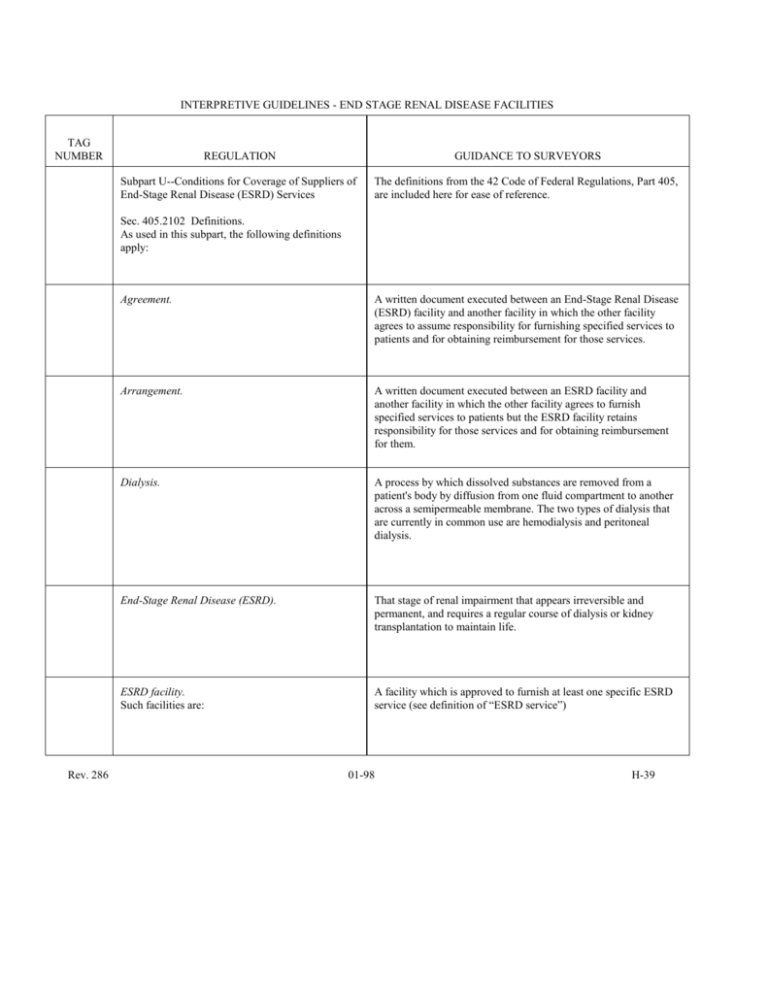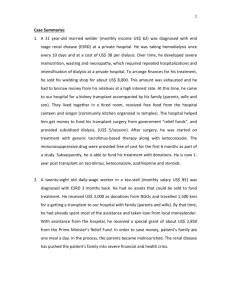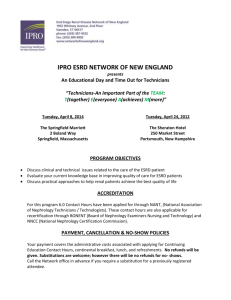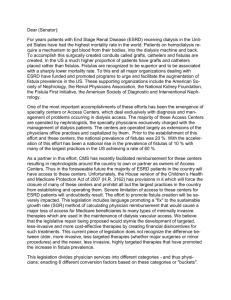interpretive guidelines - end stage renal disease facilities
advertisement

INTERPRETIVE GUIDELINES - END STAGE RENAL DISEASE FACILITIES TAG NUMBER REGULATION GUIDANCE TO SURVEYORS Subpart U--Conditions for Coverage of Suppliers of End-Stage Renal Disease (ESRD) Services The definitions from the 42 Code of Federal Regulations, Part 405, are included here for ease of reference. Sec. 405.2102 Definitions. As used in this subpart, the following definitions apply: Rev. 286 Agreement. A written document executed between an End-Stage Renal Disease (ESRD) facility and another facility in which the other facility agrees to assume responsibility for furnishing specified services to patients and for obtaining reimbursement for those services. Arrangement. A written document executed between an ESRD facility and another facility in which the other facility agrees to furnish specified services to patients but the ESRD facility retains responsibility for those services and for obtaining reimbursement for them. Dialysis. A process by which dissolved substances are removed from a patient's body by diffusion from one fluid compartment to another across a semipermeable membrane. The two types of dialysis that are currently in common use are hemodialysis and peritoneal dialysis. End-Stage Renal Disease (ESRD). That stage of renal impairment that appears irreversible and permanent, and requires a regular course of dialysis or kidney transplantation to maintain life. ESRD facility. Such facilities are: A facility which is approved to furnish at least one specific ESRD service (see definition of “ESRD service”) 01-98 H-39 INTERPRETIVE GUIDELINES - END STAGE RENAL DISEASE FACILITIES TAG NUMBER Rev. 286 REGULATION GUIDANCE TO SURVEYORS (a) Renal Transplantation Center. A hospital unit which is approved to furnish directly transplantation and other medical and surgical specialty services required for the care of the ESRD transplant patients, including inpatient dialysis furnished directly or under arrangement. A Renal Transplantation Center may also be a Renal Dialysis Center. (b) Renal dialysis center. A hospital unit which is approved to furnish the full spectrum of diagnostic, therapeutic, and rehabilitative services required for the care of ESRD dialysis patients (including inpatient dialysis furnished directly or under arrangement). A hospital need not provide renal transplantation to qualify as a renal dialysis center. (c) Renal dialysis facility. A unit which is approved to furnish dialysis service(s) directly to ESRD patients. (d) Self-dialysis unit. A unit that is part of an approved renal transplantation center, renal dialysis center, or renal dialysis facility, and furnishes self-dialysis services. (e) Special purpose renal dialysis facility. A renal dialysis facility which is approved under 42 CFR §405.2164 to furnish dialysis at special locations on a short-term basis to a group of dialysis patients otherwise unable to obtain treatment in the geographical area. The special locations must be either special rehabilitative (including vacation) locations serving ESRD patients temporarily residing there, or locations in need of ESRD facilities under emergency circumstances. 01-98 H-40 INTERPRETIVE GUIDELINES - END STAGE RENAL DISEASE FACILITIES TAG NUMBER REGULATION GUIDANCE TO SURVEYORS ESRD service. The type of care or services furnished to an ESRD patient. Such types of care are: (a) Transplantation service. A process by which (1) a kidney is excised from a live or cadaveric donor, (2) that kidney is implanted in an ESRD patient, and (3) supportive care is furnished to the living donor and to the recipient following implantation. (b) Dialysis service-(1) Inpatient dialysis Dialysis which, because of medical necessity, is furnished to an ESRD patient on a temporary inpatient basis in a hospital; (2) Outpatient dialysis. Outpatient dialysis includes: Dialysis furnished on an outpatient basis at a renal dialysis center or facility. (i) Staff-assisted dialysis. Dialysis performed by the staff of the center or facility. (ii) Self-dialysis. Dialysis performed, with little or no professional assistance, by an ESRD patient who has completed an appropriate course of training. Rev. 286 (3) Home dialysis. Dialysis performed by an appropriately trained patient at home. (c) Self-dialysis and home dialysis training;. A program that trains ESRD patients to perform self-dialysis or home dialysis with little or no professional assistance, and trains other individuals to assist patients in performing self-dialysis or home dialysis. Furnishes directly. The ESRD facility provides the service through its own staff and employees, or through individuals who are under direct contract to furnish such services personally for the facility (i.e., not through “agreements” or “arrangements”). 01-98 H-41 INTERPRETIVE GUIDELINES - END STAGE RENAL DISEASE FACILITIES TAG NUMBER Rev. 286 REGULATION GUIDANCE TO SURVEYORS Furnishes on the premises. The ESRD facility furnishes services on its main premises; or on its other premises that are (a) contiguous with or in immediate proximity to the main premises, and under the direction of the same professional staff and governing body as the main premises, or (b) approved on a time-limited basis as a special purpose renal dialysis facility. Histocompatibility testing. Laboratory test procedures which determine compatibility between a potential organ donor and a potential organ transplant recipient. Medical care criteria. Predetermined elements against which aspects of the quality of a medical service may be compared. They are developed by professionals relying on professional expertise and on the professional literature. Medical care norms. Numerical or statistical measures of usual observed performance. Norms are derived from aggregate information related to the health care provided to a large number of patients over a period of time. Medical care standards. Professionally developed expressions of the range of acceptable variation from a norm or criterion. Medical care evaluation study (MCE). Review of health care services, usually performed retrospectively, in which an indepth assessment of the quality and/or utilization of such services is made. Network, ESRD. All Medicare-approved ESRD facilities in a designated geographic area specified by HCFA. 01-98 H-42 INTERPRETIVE GUIDELINES - END STAGE RENAL DISEASE FACILITIES TAG NUMBER REGULATION GUIDANCE TO SURVEYORS Network organization. The administrative governing body to the network and liaison to the Federal government. Organ procurement. The process of acquiring donor kidneys. (See definition of Organ Procurement Organization in §485.302 of this chapter.) Qualified personnel. Personnel that meet the requirements specified by the following: (a) Chief executive officer. A person who: (1) Holds at least a baccalaureate degree or its equivalent, and has at least 1 year of experience in an ESRD unit; or (2) Is a registered nurse or physician director as defined in this definition; or (3) As of September 1, 1976, has demonstrated capability by acting for at least 2 years as a chief executive officer in a dialysis unit or transplantation program. (b) Dietitian. A person who: (1) Is eligible for registration by the American Dietetic Association under its requirements in effect on June 3, 1976, and has at least 1 year of experience in clinical nutrition; or (2) Has a baccalaureate or advanced degree with major studies in food and nutrition or dietetics, and has at least 1 year of experience in clinical nutrition. Rev. 286 01-98 H-43 INTERPRETIVE GUIDELINES - END STAGE RENAL DISEASE FACILITIES TAG NUMBER REGULATION (c) Medical record practitioner. GUIDANCE TO SURVEYORS A person who: (1) Has graduated from a program for Medical Record Administrators accredited by the Council on Medical Education of the American Medical Association and the American Medical Record Association, and is eligible for certification as a Registered Record Administrator (RRA) by the American Medical Record Association under its requirements in effect on June 3, 1976; or (2) Has graduated from a program for Medical Record Technicians approved jointly by the Council on Medical Education of the American Medical Association and the American Medical Record Association, and is eligible for certification as an Accredited Record Technician (ART) by the American Medical Record Association under its requirements in effect June 3, 1976; or (3) Has successfully completed and received a satisfactory grade in the American Medical Record Association's Correspondence Course for Medical Record Personnel approved by the Accrediting Commission of the National Home Study Council, and is eligible for certification as an Accredited Record Technician by the American Medical Record Association under its requirements in effect June 3, 1976. (d) Nurse responsible for nursing service. A person who is licensed as a registered nurse by the State in which practicing, and: (1) Has at least 12 months of experience in clinical nursing, and an additional 6 months of experience in nursing care of the patient with permanent kidney failure or undergoing kidney transplantation, including training in and experience with the dialysis process; or (2) Has 18 months of experience in nursing care of the patient on maintenance dialysis, or in nursing care of the patient with a kidney transplant, including training in and experience with the dialysis process; or (3) If the nurse responsible for nursing service is in charge of self-care dialysis training, at least 3 months of the total required ESRD experience is in training patients in self-care. Rev. 286 01-98 H-44 INTERPRETIVE GUIDELINES - END STAGE RENAL DISEASE FACILITIES TAG NUMBER REGULATION (e) Physician-director. GUIDANCE TO SURVEYORS A physician who: (1) Is board eligible or board certified in internal medicine or pediatrics by a professional board, and has had at least 12 months of experience or training in the care of patients at ESRD facilities; or (2) During the 5-year period prior to September 1, 1976, served for at least 12 months as director of a dialysis or transplantation program; or (3) In those areas where a physician who meets the definition in paragraph (1) or (2) of this definition is not available to direct a participating dialysis facility, another physician may direct the facility subject to the approval of the Secretary. (f) Social worker. A person who is licensed, if applicable, by the State in which practicing, and: (1) Has completed a course of study with specialization in clinical practice at, and holds a masters degree from, a graduate school of social work accredited by the Council on Social Work Education; or (2) Has served for at least 2 years as a social worker, 1 year of which was in a dialysis unit or transplantation program prior to September 1, 1976, and has established a consultative relationship with a social worker who qualifies under paragraph (f)(1) of this definition. (g) Transplantation surgeon. A person who: (1) Is board eligible or board certified in general surgery or urology by a professional board; and (2) Has at least 12 months training or experience in the performance of renal transplantation and the care of patients with renal transplants. Rev. 286 01-98 H-45 INTERPRETIVE GUIDELINES - END STAGE RENAL DISEASE FACILITIES TAG NUMBER V100 REGULATION GUIDANCE TO SURVEYORS §405.2135 Condition: Compliance with Federal, state and local laws and regulations. Interpretive Guidelines: §405.2135 The ESRD facility is in compliance with applicable Federal, State and local laws and regulations. Failure of an ESRD facility to meet an applicable Federal, State, or local law may be cited when the Federal, State, or local authority having jurisdiction has made a determination of non-compliance and has taken a final adverse action (sanction) as a result and there is continued noncompliance. If State law provides for the licensure of ESRD facilities, request to see a copy of the current license. If you suspect that you have observed non-compliance with an applicable Federal law related to the provider's ESRD program, notify the HCFA RO. The RO will notify the appropriate Federal agency of your observations. Applicable Federal laws include the Food and Drug Administration's (FDA) Medical Device Reporting requirements, the Occupational Safety and Health Administration's (OSHA's) environmental and training requirements, and the Office of Civil Rights' (OCR's) anti-discrimination requirements. Under the FDA's Medical Device Reporting requirements, the facility must notify the FDA (1-800-638-6725) and the manufacturer if a medical device may have caused or contributed to a death using User Facility reporting requirements. If a device may have caused and/or contributed to a serious injury or serious illness, the facility notifies the manufacturer if they know the name of the manufacturer, or the FDA if they do not know the name of the manufacturer. V101 (a) Standard: Licensure. Interpretive Guidelines: §405.2135(a) Where State or applicable local law provides for the licensing of ESRD facilities, the facility is: An ESRD facility is responsible for meeting all State and local laws. (1) Licensed pursuant to such law; or V102 Rev. 286 (2) Approved by the agency of such State or locality responsible for such licensing as meeting the standards established for such licensing. §405.2135(a)(2) 01-98 H-46 INTERPRETIVE GUIDELINES - END STAGE RENAL DISEASE FACILITIES TAG NUMBER REGULATION V103 (b) Standard: Licensure or registration of personnel. GUIDANCE TO SURVEYORS §405.2135(b) Each staff member is currently licensed or registered in accordance with applicable law. V104 (c) Standard: Conformity with other laws. §405.2135(c) The facility is in conformity with applicable laws and regulations pertaining to fire safety, equipment, and other relevant health and safety requirements. V110 §405.2136 Condition: Governing body and management. Interpretive Guidelines: §405.2136 The ESRD facility is under the control of an identifiable governing body, or designated person(s) so functioning, with full legal authority and responsibility for the governance and operation of the facility. If a facility is owned by a larger corporate entity, determine who is responsible for the operations, policies, and procedures at the facility. Does the facility follow corporate-based policies or does the facility follow the policies of its own governing body that differ from the corporate entity? How do these two governing bodies interact? It is not required that there be a corporate and a local governing body; however, it is important to know which has the ultimate authority for the governance and operation of the facility. Interpretive Guidelines: §405.2136 V111 The governing body adopts and enforces rules and regulations relative to its own governance. If in doubt about a facility’s particular practice, review the policies and procedures relative to the questionable practice to see if they are in keeping with standard quality of care. Survey Procedures and Probes: §405.2136 How does the governing body enforce the rules? Interpretive Guidelines: §405.2136 V112 And to the health care and safety of patients, The governing body should assure that the facility has and maintains an ongoing quality assurance program that continually monitors its operations, and ensures the delivery of quality care to ESRD patients. Rev. 286 01-98 H-47 INTERPRETIVE GUIDELINES - END STAGE RENAL DISEASE FACILITIES TAG NUMBER REGULATION GUIDANCE TO SURVEYORS V113 To the protection of the patients' personal and property rights, and §405.2136 V114 To the general operation of the facility. §405.2136 V115 The governing body receives and acts upon recommendations from the network organization. §405.2136 V116 The governing body appoints a chief executive officer who is responsible for the overall management of the facility. §405.2136 V117 (a) Standard: Disclosure of ownership. Interpretive Guidelines: §405.2136(a)(1) The ESRD facility supplies full and complete information to the State survey agency (§405.1902(a)) as to the identity of: Review the HCFA-1513 for completeness and compliance with this standard. Information required to be disclosed in this standard, but not required on the HCFA-1513 should be disclosed to the State survey agency in writing and attached to the HCFA-1513. (1) Each person who has any direct or indirect ownership interest of 10 percentum or more in the facility, or who is the owner (in whole or in part) of any mortgage, deed of trust, note, or other obligation secured (in whole or in part) by the facility or any of the property or assets of the facility; Rev. 286 01-98 H-48 INTERPRETIVE GUIDELINES - END STAGE RENAL DISEASE FACILITIES TAG NUMBER REGULATION GUIDANCE TO SURVEYORS V118 (2) Each officer and director of the corporation, if the facility is organized as a corporation; and §405.2136(a)(2) V119 (3) Each partner, if the facility is organized as a partnership; §405.2136(a)(3) V120 And promptly reports to the State survey agency any changes which would affect the current accuracy of the information so required to be supplied. Survey Procedures and Probes: §405.2136(a)(3) Has the facility made any changes in its ownership since the last survey? Did they report those changes? Cite here if the facility made changes in its ownership and did not report those changes to the State survey agency. V121 (b) Standard: Operational objectives. §405.2136(b) The operational objectives of the ESRD facility, including the services that it provides, are established by the governing body and delineated in writing. The governing body adopts effective administrative rules and regulations that are designed to safeguard the health and safety of patients and to govern the general operations of the facility, in accordance with legal requirements. V122 Rev. 286 Such rules and regulations are in writing and dated. §405.2136(b) 01-98 H-49 INTERPRETIVE GUIDELINES - END STAGE RENAL DISEASE FACILITIES TAG NUMBER REGULATION GUIDANCE TO SURVEYORS V123 The governing body ensures that they are operational, and that they are reviewed at least annually and revised as necessary. §405.2136(b) V124 If the ESRD facility is engaged in the practice of hemodialyzer reuse, the governing body ensures that there are written policies and procedures with respect to reuse, to assure that recommended standards and conditions are being followed, and requires that patients be informed of the policies and procedures. Interpretive Guidelines: §405.2136(b) V125 (1) The objectives of the facility are formulated in writing and clearly stated in documents appropriate for distribution to patients, facility personnel, and the public. §405.2136(b)(1) V126 (2) A description of the services provided by the facility, together with a categorical listing of the types of diagnostic and therapeutic procedures that may be performed, is readily available upon request to all concerned. §405.2136(b)(2) Rev. 286 The review of this requirement should be coordinated with §405.2138(a), Patients' rights and responsibilities, and §405.2150, Reuse of hemodialyzers and other dialysis supplies. 01-98 H-50 INTERPRETIVE GUIDELINES - END STAGE RENAL DISEASE FACILITIES TAG NUMBER V127 REGULATION GUIDANCE TO SURVEYORS (3) Admission criteria that insure equitable access to services are adopted by the facility and are readily available to the public. Access to the self-dialysis unit is available only to patients for whom the facility maintains patient care plans (see 405.2137). Interpretive Guidelines: §405.2136(b)(3) An ESRD facility must comply with provisions of §504 of the Rehabilitation Act of 1973. Specifically, The Rehabilitation Act requires that no otherwise qualified person with a disability be denied access to, or the benefits of, or be subject to discrimination by any program or activity provided by any institution or entity receiving federal funds. This provision ensures that patients with the human immunodeficiency virus (HIV) cannot be denied access to care because of their HIV status. The admission policies should delineate which patients will or will not be treated by the facility. These policies must apply to all patients equally, without regard to their health status or method of payment, e.g., private pay, Medicare and Medicaid. If the admission policies of the facility specifically exclude or define practices that constitute unequal treatment of HIV-positive patients, cite noncompliance here and notify the HCFA RO’s Office of Civil Rights for followup. If you suspect violation of civil rights that is not specific to the admission criteria of the facility but appears to be facility practice, do not cite noncompliance here. Refer the situation to the HCFA RO, Office of Civil Rights for followup. Survey Procedures and Probes: §405.2136(b)(3) What evidence is there to indicate that the admission policies are applied equitably to all individuals? V128 V129 Rev. 286 (4) The operational objectives and administrative rules and regulations of the facility are reviewed at least annually and revised as necessary by the administrative staff, medical director, and other appropriate personnel of the facility, and are adopted when approved by the governing body. Survey Procedures and Probes: §405.2136(b)(4) (c) Standard: Chief executive officer. Interpretive Guidelines: §405.2136(c) The governing body appoints a qualified chief executive officer who, as the ESRD facility's administrator: Is responsible for the overall management of the facility; enforces the rules The chief executive officer (CEO) as defined at §405.2102 is a person who: (1) Holds at least a baccalaureate degree or its equivalent and has at least one year of experience in an ESRD unit; (2) is a registered nurse or physician director as defined in the regulations; or (3) as of September 1, 1976, has demonstrated capability by acting for at least two years as a chief executive officer in a dialysis unit or transplantation unit. How long has it been since the facility's operational objectives have been reviewed? Is the review documented? 01-98 H-51 INTERPRETIVE GUIDELINES - END STAGE RENAL DISEASE FACILITIES TAG NUMBER REGULATION GUIDANCE TO SURVEYORS and regulations relative to the level of health care and safety of patients, and to the protection of their personal and property rights; and plans, organizes, and directs those responsibilities delegated to him by the governing body. Survey Procedures and Probes: §405.2136(c) Each ESRD facility has peer review-type oversight that is separate from the RO survey and certification program to protect the individual ESRD patient’s personal and property rights. This oversight is provided by the 18 ESRD Network offices strategically located throughout the country. In general, the Network monitors an ESRD facility for compliance with patient-focused goals and activities it has previously determined for that facility. What are the facility’s Network goals? How does the CEO assure Network interacttion with the facility? How does the CEO monitor these goals? How does the CEO monitor the facility’s action on the recommendations of the Network? V130 Through meetings and periodic reports, the chief executive officer maintains on-going liaison among the governing body, the medical and nursing personnel, and other professional and supervisory staff of the facility, and acts upon recommendations made by the medical staff and the governing body. Survey Procedures and Probes: §405.2136(c) In the absence of the chief executive officer, a qualified person is authorized in writing to act on the officer's behalf. Interpretive Guidelines: §405.2136(c) V132 (1) The governing body delineates in writing the responsibilities of the chief executive officer, and ensures that he/she is sufficiently free from other duties to provide effective direction and management of the operations and fiscal affairs of the facility. §405.2136(c)(1) V133 (2) The chief executive officer serves on a full-time or part-time basis, in accordance with the scope of the facility's operations and administrative needs, and devotes sufficient time to the conduct of such responsibilities. §405.2136(c)(2) V131 Rev. 286 How does the CEO communicate with the governing body and with the professional and administrative staff? The qualified alternate must meet the requirements specified for the CEO. (See definition at §405.2102, page H-43). 01-98 H-52






